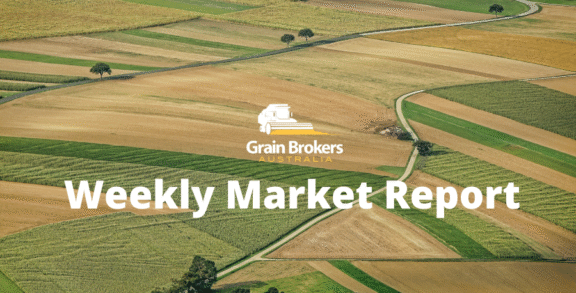
Bearish news pushes markets lower…
Market news and market actions late last week were highlighted by the release of the latest International Grains Council (IGC) market report on Thursday followed by the release of prospective plantings and grain stocks reports by the United States Department of Agriculture (USDA) on Friday.
The IGC report was their first complete set of supply and demand numbers for the 2019/20 season (July 2019 to June 2020). In summary, the forecast increase in total wheat and coarse grains production will compensate for lower opening stocks, but with a substantial increase in demand expected, a further drawdown of closing stocks is forecast. Closing wheat and coarse grain inventories are estimated to fall by 29 million metric tonnes (MMT) over the 2019/20 season to 575MMT.
This drawdown is primarily due to corn, where opening stocks are down for the third successive season and demand is expected to increase year on year. The small increase in estimated global production of 10MMT is not nearly enough to cover the lower opening stocks and an expected rise in consumption of around 14MMT.
Global wheat production is forecast to increase to 759MMT, a rise of 24MMT over the 2018/19 season, but still 4MMT short of the record of 763MMT set in 2016/17. Global consumption is forecast to increase in 2019/20 but by less than production leading to a relatively minor increase of 6MMT in ending stocks to 270MMT.
Looking at individual producers, the IGC pencilled in Australia for a modest 22.9MMT, a significant rebound on the drought-ravaged production of 17.3MMT in 2018/19. Argentinian production is forecast to fall fractionally to 19.1MMT. In North America, Canada is expected to reap 32.6MMT of wheat, up less than 1MMT on last season, and the United States (US) harvest is expected to be 50.7MMT in 2019/20, compared to 51.3MMT this season.
The European Union (EU) is forecast to increase wheat production by 7 per cent from 137.9MMT in 2018/19 to 149MMT next season, the Russian wheat crop is estimated at 77.1MMT compared to 71.7MMT this year and the IGC has projected that their Black Sea neighbour, Ukraine, will have a 10 per cent increase in wheat production to 27.5MMT.
The number with the most room to move at the moment appears to be Russian production. In 2017/18 initial forecasts started below the current IGC forecast of 77.1MMT and finished up at a record 85.1MMT. Current conditions are reported to be extremely favourable for the maturing winter crop, and rumours emanating from Russia suggest that the record could be in jeopardy if these conditions continue through to this year’s harvest.
International barley production is forecast to rebound by 5 per cent, or 7MMT, to 149MMT in 2019/20. Global barley stocks are currently forecast to end the 2018/19 marketing year at a 23 year low of around 23MMT, but the IGC expects a small turnaround in that trend, finishing the 2019/20 season up around 2MMT at just under 25MMT.
US corn futures fell 4 per cent on Friday, their biggest single-session drop since July 2016, after the USDA released their latest grain stocks report and results of their annual planting survey. Soybeans and wheat followed the downward trend despite the USDA’s lower than expected spring wheat and soybean acreage projections.
The USDA forecast the corn area at 92.8 million acres across the US in the next marketing year. This is up 4 per cent on the current season and is a three-year high. The forecast was 1.5 million acres higher than trade expectations. Not surprisingly, the rise in the corn area came at the expense of the soybean acreage, which fell by 5 per cent to 84.6 million acres. This compared to trade expectations of 86.2 million acres.
On the wheat front, the USDA estimates that US farmers will plant 12.8 million acres of spring wheat this season. This compares to the long term average of 13.4 million acres and is 3 per cent lower than the 13.2 million acres planted last year. Winter wheat plantings were estimated at 31.5 million acres, down more than 3 per cent from the 32.5 million acres in the 2018/19 season. This means total wheat plantings in the US are estimated at a record low of 44.3 million acres.
The grower survey was conducted in the first two weeks of March, so there is significant uncertainty around how much the planting intentions will be impacted by the floods across the Midwest in the last three weeks. The growers who completed the survey early may have done so before the flooding. Those that completed it at the back end of the survey period may well have made some adjustments to their projections as a result of the floods.
Don’s Party (the US-Chine trade war) has obviously had a massive impact on US grain stocks. Export sales struggle to meet expectations and the negotiations continue with Beijing without any signs that the impasse will be resolved any time soon. As at March 1, the USDA pegged domestic corn supplies at 8.6 billion bushels (218.5MMT), down 3 per cent on the same time last year but the third biggest on record.
US wheat stocks came in at 1.59 billion bushels (43.3MMT) the second largest March 1 number in 31 years and is 6 per cent higher than last year’s 1.5 billion bushels (40.8MMT). The most significant year-on-year increase belongs to soybeans which posted their largest ever March 1 figure of 2.72 billion bushels (74MMT). This is a whopping 29 per cent increase on the same time last year.
On the whole, last week’s IGC and USDA reports were bearish, and the US futures markets reacted accordingly. In addition, the northern hemisphere winter crop appears to be progressing well, and there are currently no red flags to raise production concerns in any of the crucial winter crop jurisdictions.
Big wheat stocks in the US, the potential for a huge Russian wheat crop and a general rebound to near-record global wheat production is not the recipe for an escalation in global values. The autumn break is yet to arrive in many areas of Australia, but as production certainty increases current new crop prices should provide growers with enough incentive to lock away some production margin before the northern hemisphere harvest commences.
Call your local Grain Brokers Australia representative on 1300 946 544 to discuss your grain marketing





